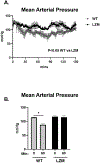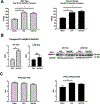Sacubitril/Valsartan Improves Left Ventricular Function in Chronic Pressure Overload Independent of Intact Cyclic Guanosine Monophosphate-dependent Protein Kinase I Alpha Signaling
- PMID: 32464187
- PMCID: PMC7529795
- DOI: 10.1016/j.cardfail.2020.04.011
Sacubitril/Valsartan Improves Left Ventricular Function in Chronic Pressure Overload Independent of Intact Cyclic Guanosine Monophosphate-dependent Protein Kinase I Alpha Signaling
Abstract
Background: Combined angiotensin receptor/neprilysin inhibition with sacubitril/valsartan (Sac/Val) has emerged as a therapy for heart failure. The presumed mechanism of benefit is through prevention of natriuretic peptide degradation, leading to increased cyclic guanosine monophosphate (cGMP)-dependent protein kinase (PKG) signaling. However, the specific requirement of PKG for Sac/Val effects remains untested.
Methods and results: We examined Sac/Val treatment in mice with mutation of the cGMP-dependent protein kinase I (PKGI)α leucine zipper domain, which is required for cGMP-PKGIα antiremodeling actions in vivo. Wild-type (WT) or PKG leucine zipper mutant (LZM) mice were exposed to 56-day left ventricular (LV) pressure overload by moderate (26G) transaortic constriction (TAC). At day 14 after TAC, mice were randomized to vehicle or Sac/Val by oral gavage. TAC induced the same degree of LV pressure overload in WT and LZM mice, which was not affected by Sac/Val. Although LZM mice, but not WT, developed LV dilation after TAC, Sac/Val improved cardiac hypertrophy and LV fractional shortening to the same degree in both the WT and LZM TAC mice.
Conclusion: These findings indicate the beneficial effects of Sac/Val on LV structure and function in moderate pressure overload. The unexpected finding that PKGIα mutation does not abolish the Sac/Val effects on cardiac hypertrophy and on LV function suggests that signaling other than natriuretic peptide- cGMP-PKG mediates the therapeutic benefits of neprilysin inhibition in heart failure.
Copyright © 2020 Elsevier Inc. All rights reserved.
Figures




References
-
- McMurray JJ, Packer M, Desai AS, Gong J, Lefkowitz MP, Rizkala AR, Rouleau JL, Shi VC, Solomon SD, Swedberg K and Zile MR. Angiotensin-neprilysin inhibition versus enalapril in heart failure. N Engl J Med. 2014;371:993–1004. - PubMed
-
- Solomon SD, Zile M, Pieske B, Voors A, Shah A, Kraigher-Krainer E, Shi V, Bransford T, Takeuchi M, Gong J, Lefkowitz M, Packer M and McMurray JJ. The angiotensin receptor neprilysin inhibitor LCZ696 in heart failure with preserved ejection fraction: a phase 2 double-blind randomised controlled trial. Lancet. 2012;380:1387–95. - PubMed
-
- Lluri G, Lin J, Reardon L, Miner P, Whalen K and Aboulhosn J. Early Experience With Sacubitril/Valsartan in Adult Patients With Congenital Heart Disease. World J Pediatr Congenit Heart Surg. 2019;10:292–295. - PubMed
-
- Singh JSS, Burrell LM, Cherif M, Squire IB, Clark AL and Lang CC. Sacubitril/valsartan: beyond natriuretic peptides. Heart (British Cardiac Society). 2017;103:1569–1577. - PubMed
-
- Zois NE, Bartels ED, Hunter I, Kousholt BS, Olsen LH and Goetze JP. Natriuretic peptides in cardiometabolic regulation and disease. Nature reviews Cardiology. 2014;11:403–12. - PubMed
MeSH terms
Substances
Grants and funding
LinkOut - more resources
Full Text Sources
Medical

